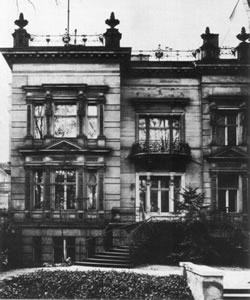
Eighty years ago, in October 1939, Adolf Hitler signed a memo. He instructed SS officer Dr. Karl Brandt, his personal physician, and Philipp Bouhler, Chief of the Chancellery of the Führer, to “broaden the powers of physicians designated by name, who will decide whether those who have—as far as can be humanly determined—incurable illnesses can, after the most careful evaluation, be granted a mercy death.”
But the memo we have today is dated September 1, 1939. Evidence shows Hitler backdated it to September 1 so it would seem directly related to the war, which officially began that day. The planning and killing of sanatorium and nursing home patients had already been contemplated as early as 1935, but Hitler thought the killing of patients during wartime would be easier to conceal.
Earlier, in May 1939, Hitler had received a request from the parents of Gerhard Kretschmar, who was born blind and missing limbs. The Kretschmars wanted to kill their child. Hitler authorized Brandt to have Gerhard killed. Records show Gerhard died on July 15 of “heart weakness.” He was five months old.
Historians look at the murder of Gerhard Kretshmar as the beginning of Aktion T4, the Nazi “euthanasia” program. From January 1940 until the end of 1941, when Aktion T4 officially ended, 70,000 people with disabilities were murdered at six sites: Brandenburg, Bernburg, Grafeneck, Hadamar, Hartheim, and Pirna-Sonnenstein. Though T4 officially ended in 1941, 230,000 more people with disabilities were killed, including shell-shocked German soldiers, by other means from 1941 until 1945.
On August 18, 1939, only three weeks after Gerhard Kretschmar was killed, Brandt and Bouhler began the system for registering children with disabilities. Doctors were required to notify the Reich Committee for the Scientific Registering of Serious Hereditary and Congenital Illnesses—a panel of “expert” pediatricians, psychiatrists, and jurists—about children up to three years old who had mental and physical disabilities. The Committee was the central office that recorded and organized “child euthanasia.” They decided which of these children would be killed.
When I was born in 1960 nobody knew whether I would live or die. Born a month premature, missing bones in my legs, I spent the first four weeks of my life in an incubator. I was fortunate to have a doctor, and parents, who saw to it that the body with which I was born was kept intact. I was able to walk by the time I turned one year old.
Doctors were instrumental in allowing Aktion T4 to happen. Not only were they part of the selection process, deciding which of the disabled would be killed but doctors literally turned on the gas in the T4 killing centers.
What most people don’t...
You have reached your article limit
Sign up for a digital subscription and continue reading all new issues, plus our entire archives, for just $1.50/month.
Already a subscriber? Sign in




